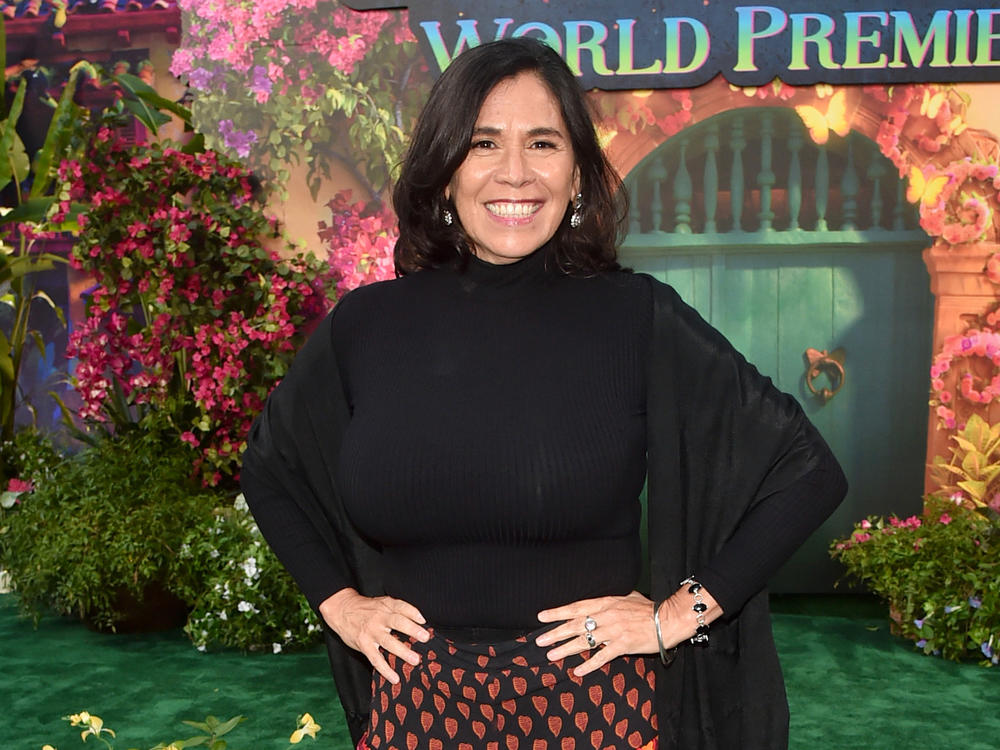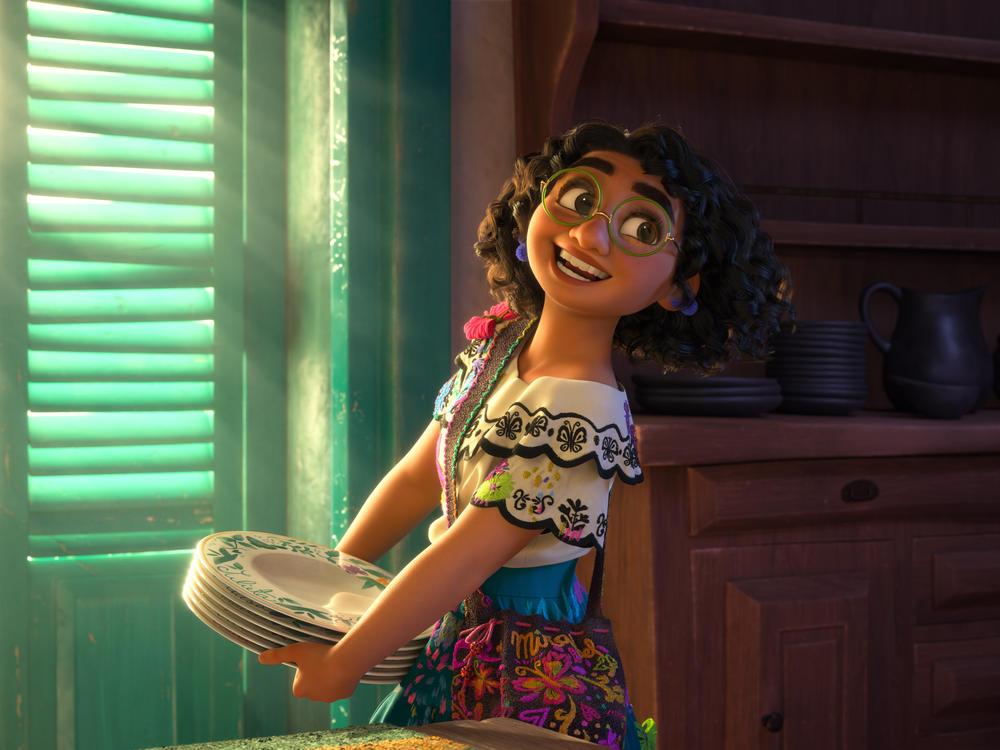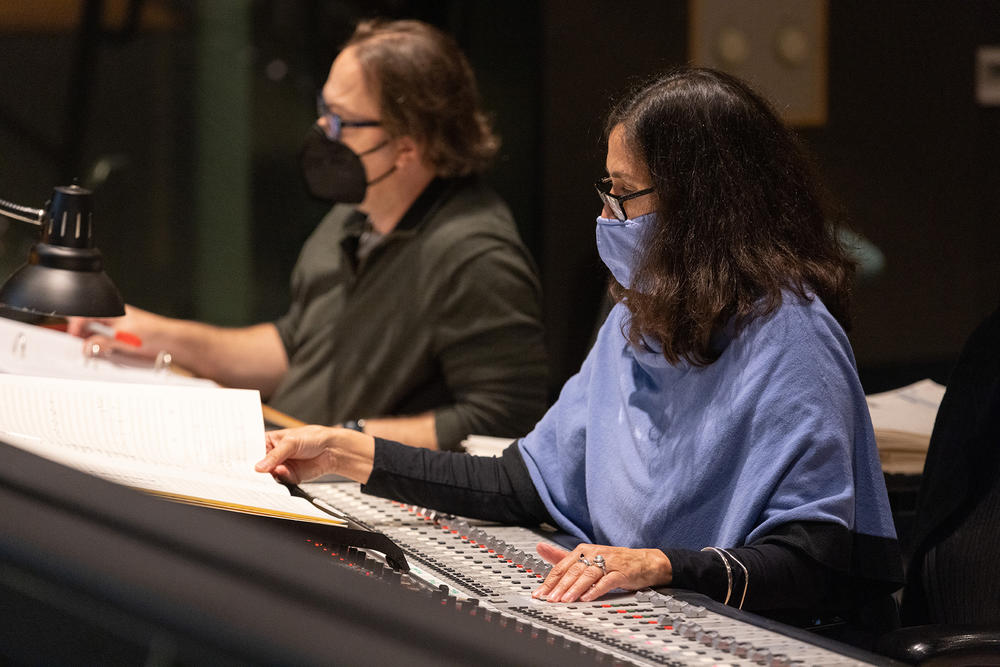Section Branding
Header Content
Sure, 'Encanto' has fun songs and a sweet story. But Germaine Franco made it groove
Primary Content
When Germaine Franco was a little girl, her fifth-grade music teacher gave her a choice. Presented with a picture of all the instruments in the orchestra, Franco pointed at her future. "I was only 10," she says, "and I was very adamant. I was asked, 'Oh, don't you want to play the flute? Don't you want to play the violin? Girls play the violin.' I said, 'Nope, I'm playing the drums.' "
The right music can make a movie sing, or make it groove. Franco's scores do both. There are, of course, plenty of singable songs in her latest project, the Disney animated musical Encanto: Lin-Manuel Miranda's genre-hopping songbook has blown up Billboard, with the sleeper hit "We Don't Talk About Bruno" becoming the highest-charting song from a Disney animated film since Aladdin's "A Whole New World" in 1993. But the pulse of the film belongs to Franco, whose instrumental score bops with cumbia, joropo and other high-energy Colombian rhythms, carried by a battery of traditional Latin American instruments.
This month, that score made Franco an Oscar nominee — putting her far-from-household name on the ballot next to Hans Zimmer (Dune), industry titan of the past 35 years, as well as Nicholas Britell (Don't Look Up) and Jonny Greenwood (The Power of the Dog), two of the 21st century's "it" composers. She is, incredibly, only the sixth woman in Academy Award history to be nominated for best original score, and the first Latina. More than that, Encanto is Disney Animation's first feature to be scored by a woman — ever.
But while Franco is used to being the only woman in the room, what really sets her apart from her peers might stretch all the way back to that fateful decision in fifth grade: a unique perspective of the world — and the movies — as seen from the rhythm section.
Franco grew up in El Paso, on the southwestern border of Texas. Mariachi and jarocho music filled the air at home, but as a '70s kid she also loved bands like Steely Dan, Foreigner and Chicago, paying special attention to the drummers and their arrangements. "She would bang with a spoon whatever she could find," says her mother, Alicia, a community organizer originally from northern Mexico. "Germaine never had to be told to practice." When little Germaine's family got tired of the noise from her xylophone, she would take it into the bathroom, where she got a kick out of the natural reverb.
In high school, she was the lone girl pounding away on percussion in her concert band, marching in the drumline at football games. She had her own snare drum, which she would roll to school on a skateboard. ("And I would shine everything," she says. "I took a lot of pride in taking care of the instruments. It was so fun playing music with other people.") She thumped her way from stage band to jazz band to the El Paso Youth Symphony, where she'd jam regularly with the guys in the orchestra, and formed her own band with members of the percussion ensemble at Rice University, where she earned two music degrees.
Franco tries to bring that performance-first, jam-band vibe to scoring, where it couldn't be further from the norm. Hollywood recording sessions have strict parameters: Time is the movie studio's money, and the music also has to be perfectly synced to picture. But Franco believes that musicians play better when they're having fun, so she keeps things loose, often joining the percussionists in the back of the room. When a score really grooves, it's because "the musicians are having a great time," she says. "They're reading, but they're enjoying what they're playing. I don't think film music has to be clinical. I want it to be human."
She shares that square-peg nature with Encanto's protagonist, Mirabel Madrigal. Mirabel is the only person in her family without a magical ability: One sister creates beautiful foliage at will, another has super strength, her mother can heal wounds through her cooking. But when their enchanted mountain house mysteriously begins to fall apart, Mirabel discovers that her real gift is the key to the family's fundamental rhythm. And if you're listening closely, those rhythms tell stories of their own, with each character and even the house itself moving to a distinct groove.
For Mirabel, that groove is cumbia: You can hear the traditional Colombian folk rhythm when she walks into her family's beloved Casita for the first time, and throughout her adventure as she searches for clues. "The rhythm of the cumbia becomes the forward motion of her trying to find a solution to the problem," Franco explains. Elsewhere in the house, an Afro-Colombian choir follows Mirabel's younger cousin Antonio, who communicates with animals in his expansive bedroom inspired by the Choco rainforest. Franco went so far as to have a special marimba from the Choco region of Colombia shipped to her in pieces, and performed those parts herself on the score. She's been playing the mallets since she was young, and over time it's become a composing superpower, according to one of her old mentors.
"I always said to her, even if it's not on the marimba, write like it's on the marimba," says John Powell, the Oscar-nominated composer of How to Train Your Dragon and the Bourne franchise, and Franco's former boss. "The limitations of having two sticks in each hand and writing that way, it makes you think differently: I think she voices chords nicely because she's writing for four sticks, not a plethora of too many fingers. When people give you limitations, humans are so much more inventive because of them."
Franco met the British Powell through her brother Michael Petry, a multimedia artist and curator who had collaborated with the composer in London. In 2003 she was hired as his assistant on the techno-orchestral score for F. Gary Gray's The Italian Job, and quickly became an invaluable member of his team, playing percussion parts on many of his scores for the next 10 years. She learned the craft of writing to picture, and absorbed Powell's penchant for playful experimentation — "like when we recorded 16 bagpipe players at Sony," she laughs, "or 15 accordion players." For the 2005 animated film Robots, "He wanted to do dog and cat toys. So I went to the pet store, and there I was, tapping them all, listening to the pitches. They must have thought I was a crazy person."
"My mea culpa about this whole thing is that she was working for me for way too long," Powell says bashfully. When he finally nudged Franco out of the nest to launch a solo career, her first big get was Dope, Rick Famuyiwa's 2015 indie about a nerdy Black teen in Inglewood, Calif., which she scored with a funky pulse laden with electric guitars. For the 2019 body-swap comedy Little, she leaned into funk and R&B rhythms, and got a rare chance to revisit her drumline days via a marching-band set piece.
Prior to Encanto, her biggest mark on pop culture was Pixar's Coco — a score she didn't write, but did cover in her fingerprints, at the invitation of composer Michael Giacchino. Franco orchestrated the score and wrote additional music, and she made numerous trips to Mexico to record local musicians. She also ended up contributing several original songs, including the joyous number "Un Poco Loco" and the heartfelt closer, "Proud Corazón." "I loved Coco," says Lin-Manuel Miranda, who was working on Disney's Moana while Coco was in development. "I cried so hard. My kid was like, 'It's just a movie, Dad. It's OK.' "
Miranda wanted an all-Latinx musical team for Encanto, and called Franco personally to ask if she'd score the film. It was a dream gig with a catch or two: With COVID still raging, she couldn't travel to Colombia for research and recordings, the way her commitment to detail would ordinarily demand. She also worried that, because she isn't Colombian herself, she might not be the right composer for the job. Powell, who served as her coach on Encanto, joked in his dry British way: "Well, do you want me to do it? I'm even less Colombian than you are." Franco cleared her schedule and commenced on what would be a yearlong project, the biggest assignment she'd ever attempted on her own.
The Disney animated musical is a genre unto itself, one that has evolved alongside pop culture. Snow White and Pinocchio were almost like European operettas. Then came the Sherman Brothers' simple, catchy showtunes for Winnie the Pooh and The Jungle Book. In the late 1980s, Broadway wunderkinds Howard Ashman and Alan Menken rescued the studio from a years-long slump, injecting a musical theater sensibility into The Little Mermaid, Beauty and the Beast and Aladdin. With few exceptions, the scores for most Disney animated musicals are adapted from their song tunes (Menken famously handled both for his films). But, Miranda explains, doing both tasks is still incredibly difficult — and anyway, he enjoys collaborating.
"Germaine's job," he says, "was to first of all introduce us to Colombia and the music in that world, but also the magic in this region. There's really an ethereal, and sometimes spooky, but always kind of gorgeous evocation of this region that I think she captured so beautifully."
The score does allow a few other Latin rhythms to crash the party: There is salsa, reggaeton, a cue evocatively titled "The Dysfunctional Tango." But Franco took pains throughout to steep the music, including her orchestral arrangements of Miranda's songs, in traditional Colombian instrumentation, and make room for the Colombian musicians on her team to contribute ideas and instinct into their performances.
A historic Oscar nomination is a striking achievement for a musician who never intended to get into film to begin with. Franco's early career could have taken her anywhere: She played theater, chamber music and opera in groups from Houston to Mexico to Berlin, wrote music for her own band, and was even preparing to audition as a percussionist with major orchestras. It was a love of Latin music that brought her to California, to study with Cuban percussionist Luis Conte. And then one day, while she was working at the Los Angeles Theatre Center, a director asked her if she would score their short film.
"It changed my life," she says. "I saw my role as a musician change from just a performer to becoming a storyteller."
If you ask John Powell, though, Franco was born to do this. "She's very imaginative rhythmically, of course. She has a great idea of flow and timing and all that stuff. But I think she has this hidden weapon, which is being a songwriter, tune-writer. Then you end up with really good, interesting tunes that sort of flow," he says.
"We all have this wonderful access to the world's music," Powell adds, "but it's only people like Germaine who will go and actually, really, find out exactly how it works."
Copyright 2022 NPR. To see more, visit https://www.npr.org.



